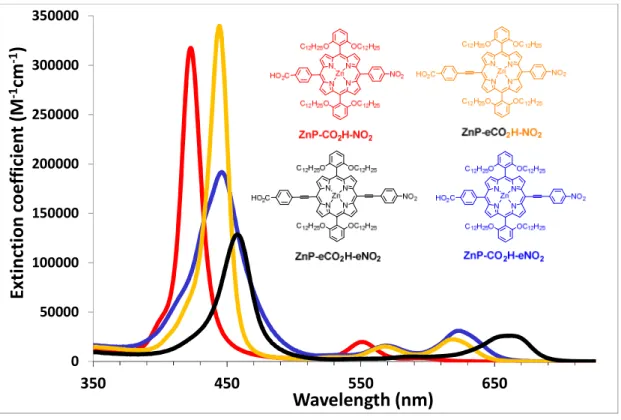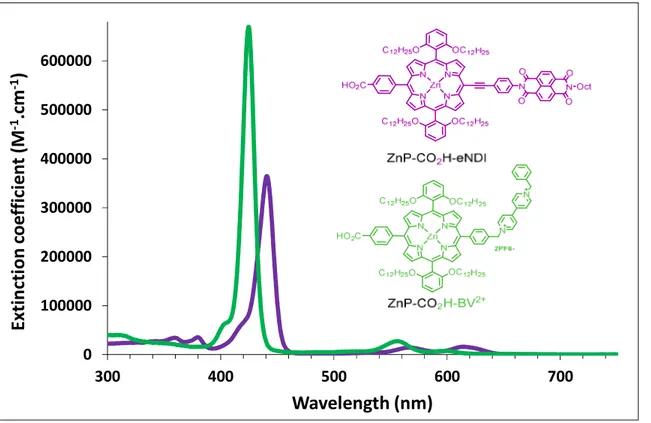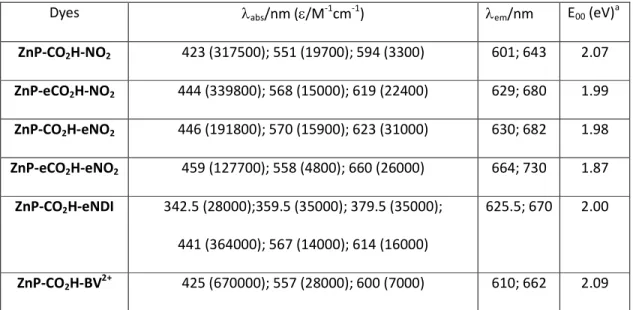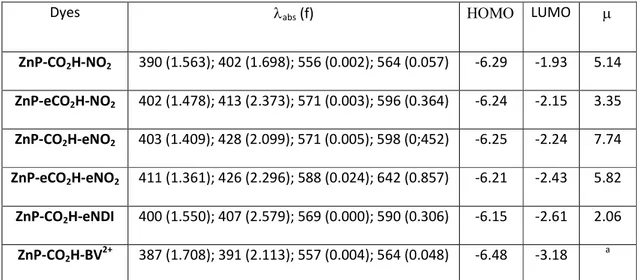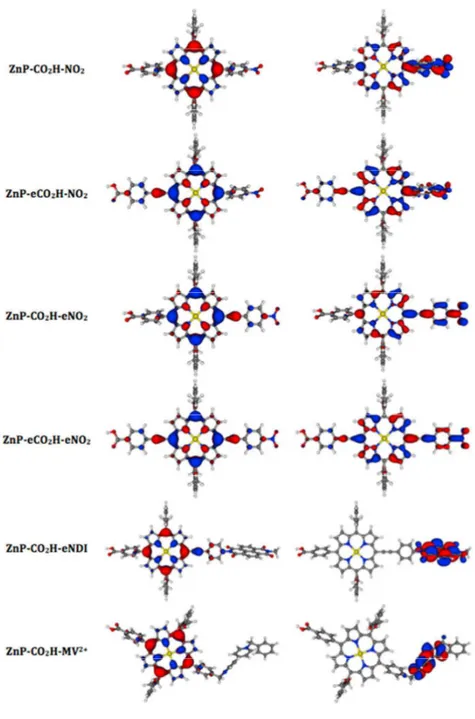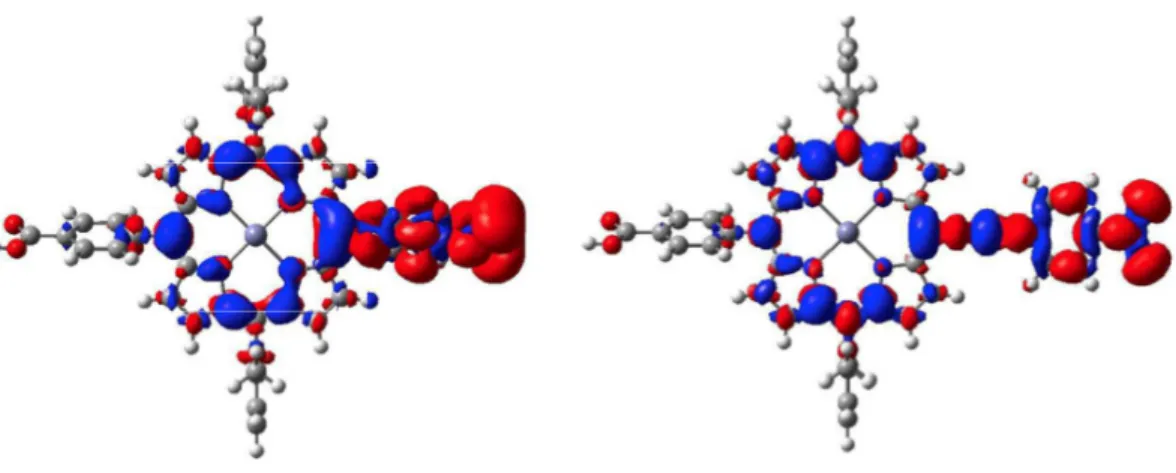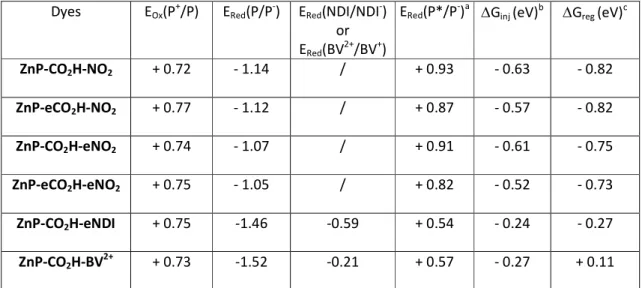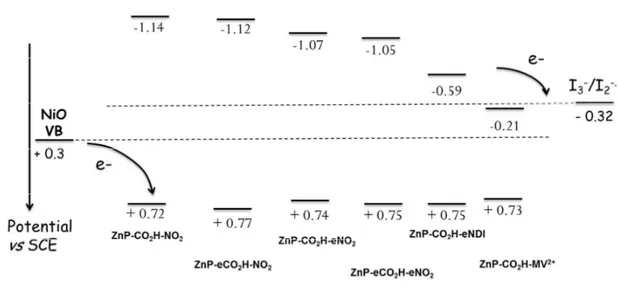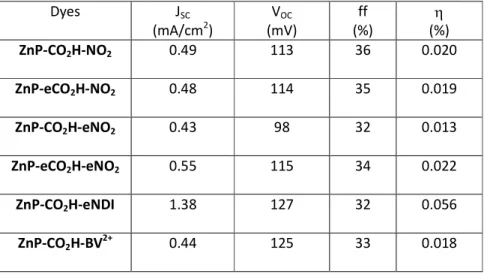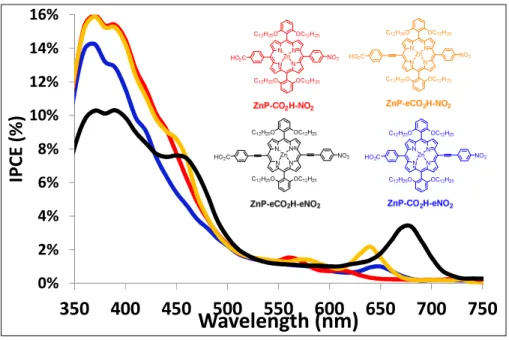HAL Id: hal-01100935
https://hal-univ-rennes1.archives-ouvertes.fr/hal-01100935
Submitted on 28 Jan 2015
HAL is a multi-disciplinary open access
archive for the deposit and dissemination of sci-entific research documents, whether they are pub-lished or not. The documents may come from teaching and research institutions in France or abroad, or from public or private research centers.
L’archive ouverte pluridisciplinaire HAL, est destinée au dépôt et à la diffusion de documents scientifiques de niveau recherche, publiés ou non, émanant des établissements d’enseignement et de recherche français ou étrangers, des laboratoires publics ou privés.
Antoine Maufroy, Ludovic Favereau, Frédéric B. Anne, Yann Pellegrin, Errol
Blart, Muriel Hissler, Denis Jacquemin, Fabrice Odobel
To cite this version:
Antoine Maufroy, Ludovic Favereau, Frédéric B. Anne, Yann Pellegrin, Errol Blart, et al.. Syn-thesis and properties of push-pull porphyrins as sensitizers for NiO based dye-sensitized solar cells. Journal of Materials Chemistry A, Royal Society of Chemistry, 2015, 3 (7), pp.3908-3917. �10.1039/C4TA05974C�. �hal-01100935�
1
Synthesis and properties of push-pull porphyrins as sensitizers for NiO based
dye-sensitized solar cells
Antoine Maufroy,ab Ludovic Favereau,a Frédéric B. Anne,a Yann Pellegrin,a Errol Blart,a Muriel Hissler,b
Denis Jacquemin,*ac Fabrice Odobel*a
a
Université LUNAM, Université de Nantes, CNRS, Chimie et Interdisciplinarité: Synthèse, Analyse, Modélisation (CEISAM), UMR 6230,2 rue de la Houssinière, 44322Nantes cedex 3,
France. E-mail: Fabrice.Odobel@univ-nantes.fr; Fax: +33 251125402; Tel: +33 251125429
b
Institut des sciences chimiques de Rennes - UMR 6226 263 Avenue du General Leclerc CS 74205 35042 Rennes cedex, France.
c
Institut Universitaire de France, 103 blvd St Michel, 75005 Paris Cedex 5, France. E-mail:
Denis.Jacquemin@univ-nantes.fr; Fax: +33 251125567; Tel: +33 251125564.
Abstract
Zinc porphyrins derivatives were prepared and investigated in NiO-based p-type dye sensitized solar cells. The first series consist of trans disubstituted push-pull porphyrins containing a nitrophenyl unit as electron withdrawing group and a benzoic acid unit as anchoring group. An ethynyl spacer was introduced between the porphyrin meso positions and the nitrophenyl or/and the benzoic acid. In a second series a secondary electron acceptor such as benzyl-viologen or a naphthalene diimide was appended to the porphyrin. All the compounds were characterized by absorption and emission spectroscopies, theoretical calculations and by electrochemistry. The fast charge recombination certainly limits the photovoltaic performances of the first series, which remain modest (Jsc ≈ 0.5 mA/cm2, Voc≈ 110 mV, ff ≈ 36% and PCE ≈ 0.02%) compared to highly performing sensitizers for NiO.
Journal
of
Materials
Chemistry
A
Accepted
Manuscript
2
However, promising performances (Jsc = 1.38 mA/cm2, Voc= 127 mV, ff = 32%, PCE=0.038%) were
recorded for the dyad with naphthalene diimide.
Introduction
The conversion of sunlight into electricity is an attractive environmentally friendly strategy to satisfy the increasing energy need of mankind. Among several photovoltaic technologies, particular attention has been devoted to dye sensitized solar cells (DSCs).1 In a classical DSC, using TiO
2 as
inorganic n-type semiconductor (n-SC), the working principle lies in the electronic transfer from the electronically excited state of the molecular dye into the conduction band of the semi-conductor. In p-DSCs, employing a p-type inorganic SC such as NiO, the operation principle is just the opposite as that of n-DSCs since photoexcitation of the sensitizer is accompanied by hole injection into the valence band (VB) of the p-SC.2 The solar energy conversion in electricity (or PCE for Power Conversion Efficiency) of the records n-DSC are as high as 12-13%.3, 4 Whilst this PCE is significantly
large, its progression has been rather slow for several years, especially when compared to emerging technologies such as perovskite-based solar cells5 or organic photovoltaic.6, 7 An elegant way to
enhance the PCE of DSC is to build tandem DSC (pn-DSC) where the photo-inert platinum counter electrode is substituted by a photocathode consisting of a dye sensitized p-type SC, such as NiO.2, 8-11
Those pn-DSCs have the potential to harvest a larger portion of the sunlight spectrum and consequently to reach much higher PCE than n-DSC. The development of pn-DSC is quite recent and only a small (but increasing) number of scientific contributions have appeared in the field.10-13 Today, the PCEs of pn-DSC, are however still lower than conventional n-DSCs (the record PCE is 2.42%),10
essentially due to the modest efficiency of the current photocathodes. To advance in the development of better performing photocathodes, new sensitizers are needed. Porphyrins are valuable dyes for solar energy conversion applications since their derivatives are the ubiquitous light
collectors in biological photosynthetic organisms (chlorophyll is the main chromophore in the
Journal
of
Materials
Chemistry
A
Accepted
Manuscript
3
photosynthetic reaction centre and light harvesting antenna) and they are very active dyes in conventional n-DSCs3, 4, 14, 15 and organic solar cells.16, 17 Furthermore, porphyrins absorb intensively
light on a broad wavelength domain and simple chemical transformations enable to tune their electronic properties to a large extent. These valuable properties prompted us to optimize porphyrin dyes to develop efficient sensitizers for NiO based p-DSC. We indeed felt that this class of dyes was under-investigated for these applications and they can certainly lead to high PCE in p-DSCs. Indeed, to the best of our knowledge, there are only three reports of porphyrin sensitizers used p-DCSs.18-20
Towards this objective, we have selected push-pull systems because this type of structures exhibits charge transfer (CT) transitions, which are particularly well suited to induce charge transfer reactions and in general push-pull dyes proved to be highly performing both in n-DSCs21 and p-DSC.22, 23 In the
present study, zinc porphyrins bear a benzoic acid as anchoring moiety and a nitrophenyl as electron withdrawing unit (Chart 1). These subunits are placed in trans within a tetraaryl porphyrin and an ethynyl unit was introduced between a zinc porphyrin and the meso aryl substituents to create push pull dyes (Chart 1).
Chart 1. Structures of the porphyrins described in this work.
Journal
of
Materials
Chemistry
A
Accepted
Manuscript
4
Porphyrins were also functionalised by two alkoxy phenyl substituents. Those lipophilic alkoxy chains enable to decrease the aggregation tendency of these planar aromatic systems and to passivate the SC surface by impeding the approach of the redox mediator from the NiO surface.24 In a second
series of sensitizers, a secondary electron acceptor (viologen: BV2+ or naphthalene diimide: NDI) was
appended to the porphyrin in order to enhance the charge separated state lifetime because this type of construction proved to be efficient for such purpose.10, 25, 26 Detailed synthesis, physico-chemistry
characterisations and photovoltaic performances are presented in this contribution and the results will be rationalised with the help of Time-Dependent Density Functional Theory (TD-DFT)
calculations. It is shown that the fast charge recombination reaction is the main factor which limits the performances of this class of dyes. However, the introduction of a secondary electron acceptor in the vicinity of the porphyrin can heal this drawback and this strategy can certainly be used to take full advantage of the light harvesting properties of porphyrin derivatives.
Experimental part
Theoretical calculations
All simulations have been achieved with the Gaussian09 program27, using Density Functional Theory
(DFT) and Time-Dependent DFT, for the ground and excited state properties, respectively. The computational protocol proceeds through a four step strategy that is efficient to determine the charge transfer features of rod-like organic dyes: 1) the ground-state geometrical parameters have been determined at the PBE0/6-31G(d) level28 [LanL2DZ pseudo-potential and basis set for Zn], via a force-minimization process using a SCF convergence threshold of at least 10-9 a.u.; 2) the vibrational
spectrum of each derivative has been determined analytically at the same level of theory, that is PBE0/6-31G(d) [LanL2DZ for Zn], and it has been checked that all structures correspond to true minima of the potential energy surface; 3) the first fifteen low-lying excited-states have been
determined within the vertical TD-DFT approximation using the CAM- B3LYP/6-31+G(d)29 [LanL2DZ
Journal
of
Materials
Chemistry
A
Accepted
Manuscript
5
for Zn] level of approximation with a tight SCF convergence threshold (at least 10-7 a.u.); 4) the
charge-transfer parameters have been estimated with the procedure defined by Le Bahers30 and
coworkersusing the CAM-B3LYP electronic densities. It proposes to evaluate the distance separating the barycenters of the electron density gain/depletion upon electron transition. All calculations systematically include a modelling of bulk solvent effects (here dichloromethane) through the Polarizable Continuum Model (PCM)31. During the simulations, the long alkyl chains have been
replaced by methyl groups (e.g., the OC12H25 have been replaced by methoxy groups) in order to
lighten the computational burden.
Synthesis
Porphyrin ZnP-eCO2H-eNO2 was prepared from the already published dibromo zinc porphyrin 1 32
following two consecutive Sonogashira’s cross coupling reactions, first with (4-nitro-phenyl)ethynyl 2 and then with (4-carboxy-phenyl)ethynyl 4 according to Lindsey copper-free conditions (Scheme 1).33
The intermediate bromo (4-nitro-phenyl)ethynyl porphyrin 3 was used again to prepare ZnP-CO2
H-eNO2. 3 was subjected to a Suzuki cross-coupling reaction with the commercially available
4-methoxycarbonylphenylboronic acid 5 followed by basic hydrolysis to furnish ZnP-CO2H-eNO2 in 51%
yield (Scheme 1).
Journal
of
Materials
Chemistry
A
Accepted
Manuscript
6
Scheme 1. Synthesis of the porphyrins ZnP-eCO2H-eNO2 and ZnP-CO2H-eNO2. Reagents and conditions: a) Pd(PPh3)4, CuI,
Et3N, THF, reflux; yield: 17%, b) Pd2(dba)3, AsPh3, Et3N, THF/MeOH (v/v: 1/1), reflux; yield: 30%, c) Pd(PPh3)4, Ba(OH)2.H2O,
THF/H2O (v/v: 3/1), reflux followed by acidic treatment; yield: 51%, d) Zn(OAc)2.4 H2O, CH2Cl2/MeOH (v/v: 1/1),
reflux followed by NaOH (1M), THF/MeOH (v/v: 8/1), reflux; yield: 100%.
ZnP-eCO2H-NO2 was prepared from the monoiodo trisisopropyl-ethynyl porphyrin 7 which was
already reported in literature.34 A first Suzuki’s cross coupling reaction with the commercially
available nitrophenyl boronic acid 8 with porphyrin 7 followed by deprotection of the TIPS group by fluoride anion and a final Sonogashira’s cross coupling reaction using copper-free conditions gave ZnP-eCO2H-NO2 with an overall yield of 45% (Scheme 2). Zn-CO2H-NO2 was prepared from the known
mono-brominated porphyrin 1134 according to two consecutive Suzuki’s cross couplings. First, the
porphyrin 11 was reacted with 4-methoxycarbonylphenyl boronic acid 5 and then the resulting coupled product 12 was brominated with NBS to afford the key intermediate 13 in high overall yield (94%). The latter serves as starting material for the synthesis of ZnP-CO2H-NO2, ZnP-CO2H-eNDI and
ZnP-CO2H-BV2+. The porphyrin 13 was subjected to a Suzuki cross-coupling reaction with the
nitrophenyl boronic acid 8 followed by basic hydrolysis and metallation with zinc acetate to furnish ZnP-CO2H-NO2 with a 67% overall yield (Scheme 2).
Journal
of
Materials
Chemistry
A
Accepted
Manuscript
7
Scheme 2. Synthesis of the porphyrins ZnP-eCO2H-NO2 and ZnP-CO2H-NO2. Reagents and conditions: a) Pd(PPh3)4,
Ba(OH)2.H2O, THF/H2O (v/v: 3/1), reflux; yield: 48%, b) Zn(OAc)2.4 H2O, CH2Cl2/MeOH (v/v: 1/1), reflux followed by TBAF,
THF, rt then Pd2(dba)3, AsPh3, Et3N, THF, reflux; yield: 95%, c) Pd(PPh3)4, Ba(OH)2.H2O THF/H2O (v/v: 3/1), reflux; yield: 99%,
d) NBS, CHCl3, rt; yield:94%, e) Pd(PPh3)4, Ba(OH)2.H2O, THF/H2O (v/v: 3/1), reflux; yield: 68%, f) aqueous NaOH (1M),
THF/MeOH (v/v: 8/1), reflux followed by Zn(OAc)2.4 H2O, CH2Cl2/MeOH (v/v: 1/1), reflux; yield: 99%.
For the synthesis of the dyads, the methyl carboxylic ester of porphyrin 13 was first hydrolysed with aqueous sodium hydroxide. The carboxylic acid free-base porphyrin 15 was then metalated with zinc acetate and subsequently coupled with the known ethynyl-NDI 166, 35 according to the Sonogashira
cross-coupling conditions to afford ZnP-CO2H-eNDI in 68% yield (Scheme 3). The second dyad was
prepared according to a Suzuki’s cross coupling reaction between porphyrin 15 and 1-(borolan)benzyl bipyridinium salt 19. The latter was synthesized by nucleophilic substitution of 4-4’-bypyridine and the commercially available (Bromomethyl)benzeneboronic acid pinacol ester 18 in good yield (77%). Finally, the benzylation of the second pyridine fragment of porphyrin 20 by an
excess of benzyl bromide afforded the desired dyad ZnP-CO2H-BV2+ in 75% yield (Scheme 3).
Journal
of
Materials
Chemistry
A
Accepted
Manuscript
8
Scheme 3. Synthesis of the porphyrin ZnP-CO2H-eNDI and ZnP-CO2H-BV
2+
. Reagents and conditions: a) NaOH (1M),
THF/MeOH (v/v: 8/1), reflux; yield: 99%, b) Zn(OAc)2.4 H2O, CH2Cl2/MeOH (v/v: 1/1), reflux followed by Pd(PPh3)4, CuI, Et3N,
THF, reflux; yield: 68%, c) Tol, reflux; yield: 77%, d) Zn(OAc)2.4 H2O, CH2Cl2/MeOH (v/v: 1/1), reflux followed by Pd(PPh3)4,
Ba(OH)2.H2O, THF/H2O (v/v: 3/1), reflux; yield: 75%, e) BrBn, ACN/CHCl3/MeOH, reflux; yield: 83%.
Electronic absorption and emission spectra
The electronic absorption spectra of the porphyrins, recorded in dichloromethane solution, are illustrated in Figure 1 and the spectroscopic data are gathered in Table 1.
Journal
of
Materials
Chemistry
A
Accepted
Manuscript
9
Figure 1. Overlay of the absorption spectra of the porphyrins ZnP-CO2H-NO2, ZnP-eCO2H-NO2,
ZnP-CO2H-eNO2 and ZnP-eCO2H-eNO2 recorded in dichloromethane.
The spectrum of ZnP-CO2H-NO2 features the classical π-π* transitions of regular tetraphenyl zinc
porphyrin (ZnTPP). Indeed, we can easily distinguish an intense Soret band around 420 nm corresponding to a transition from the ground-state to higher excited-states and the two vibronic overtones of the Q-band between 500 and 600 nm attributed to the population of the lowest-lying excited states. The introduction of ethynyl moieties between the meso position of the porphyrin and the appended aryl substituents enhances the electronic communication, and this has two effects. First, it redshifts both the Soret and the Q-bands and second it inverses the relative intensities of the vibronic bands of the lowest-lying singlet excited state. These effects were previously rationalized in the studies of push-pull porphyrins designed for non-linear optical properties.36, 37 Logically, these
two effects are more pronounced on ZnP-eCO2H-eNO2, which carries two ethynyl moieties than in
ZnP-eCO2H-NO2 and ZnP-CO2H-eNO2 which contain a single ethynyl substituent. Interestingly, for
0 50000 100000 150000 200000 250000 300000 350000 350 450 550 650
E
x
ti
n
ct
io
n
c
o
e
ff
ic
ie
n
t
(M
-1cm
-1)
Wavelength (nm)
Journal
of
Materials
Chemistry
A
Accepted
Manuscript
10
ZnP-CO2H-eNO2 and ZnP-eCO2H-eNO2 the Soret transition contains a significant charge transfer (CT)
character corresponding to an electron shift from the ZnP core to the phenyl nitro group (see TD-DFT calculations below).
Figure 2. Overlay of the absorption spectra of the dyads ZnP-CO2H-BV 2+
and ZnP-CO2H-eNDIrecorded
respectively in acetonitrile and dichloromethane solution.
The spectrum of ZnP-CO2H-BV2+ is very similar to that of ZnP-CO2H-NO2 in agreement with weak π
electronic coupling of aryl groups with porphyrin macrocycle due to the phenyl-methylene linker between the porphyrin core and the viologen moiety. Concerning ZnP-CO2H-eNDI dyad, the presence
of the ethynyl group has the same effects as in the the monoethynyl porphyrin ZnP-eCO2H-NO2 and
ZnP-CO2H-eNO2: the peaks of the Soret and the Q-bands are shifted bathochromically by ~15 nm
compared to the ZnP-CO2H-BV2+ and their relative intensity are modified as described above.
Additionally, the linked NDI unit presents its classical vibronic signature with two bands at 360 and 0 100000 200000 300000 400000 500000 600000 300 400 500 600 700
E
x
ti
n
ct
io
n
c
o
e
ff
ic
ie
n
t
(M
-1.c
m
-1)
Wavelength (nm)
Journal
of
Materials
Chemistry
A
Accepted
Manuscript
11
380 nm that indicate a weak electronic communication with the porphyrin core owing to the presence of nodes of the frontier molecular orbitals on the nitrogen of the imide groups.38
Table 1. Absorption and emission data of the porphyrins recorded in CH2Cl2 at room temperature.
Dyes λabs/nm (ε/M-1cm-1) λem/nm E00 (eV)a
ZnP-CO2H-NO2 423 (317500); 551 (19700); 594 (3300) 601; 643 2.07 ZnP-eCO2H-NO2 444 (339800); 568 (15000); 619 (22400) 629; 680 1.99 ZnP-CO2H-eNO2 446 (191800); 570 (15900); 623 (31000) 630; 682 1.98 ZnP-eCO2H-eNO2 459 (127700); 558 (4800); 660 (26000) 664; 730 1.87 ZnP-CO2H-eNDI 342.5 (28000);359.5 (35000); 379.5 (35000); 441 (364000); 567 (14000); 614 (16000) 625.5; 670 2.00 ZnP-CO2H-BV2+ 425 (670000); 557 (28000); 600 (7000) 610; 662 2.09 acalculated with the wavelength at the intersection of the absorption and emission spectra (λ
inter)
according to the equation: E00 = 1240/λinter
All porphyrins are fluorescent dyes and this feature enables to determine the zero-zero transition energy (E00) between the ground state and the first singlet excited state from the wavelength at the
intersection of the absorption and emission spectra (Table 1). Expectedly, the fluorescence of ZnP-CO2H-BV2+ and ZnP-CO2H-aNDI is significantly quenched, most probably by photoinduced electron
transfer from ZnP to the adjacent electron acceptor (BV2+ or NDI), as previously observed in similar
systems.39-42
TD-DFT calculations
To shed some light on the electronic properties of these sensitizers, TD-DFT quantum chemical
calculations were undertaken. First the theoretical calculations confirm the large twisting angles
Journal
of
Materials
Chemistry
A
Accepted
Manuscript
12
between the ZnP core and the side phenyl ring when no ethynyl segment is added. Indeed, the DFT optimizations return a nearly perfectly planar conjugated path in ZnP-eCO2H-eNO2 whereas, the
dihedral angles between the ZnP and the phenyl ring attain 64° (carboxylic side) and 62° (nitro side) in ZnP-CO2H-NO2. Table 2 lists the main computed data, whereas Figure 3 provides a graphical
representation of the frontier orbitals. For the electronic absorption, TD-DFT predicts that the Q-band is shifted by +32 nm (+34 nm) and becomes 6.4 (7.9) times more intense when going from ZnP-CO2H-NO2 toZnP-eCO2H-NO2 (ZnP-CO2H-eNO2) and this fits the experimental data of Table 1, where
the corresponding wavelength and intensity effects are +25 nm (+29 nm) and x6.7 (x9.4), respectively. Likewise compound with the two ethynyl segments, ZnP-eCO2H-eNO2, yields the most
red-shifted Q-band in both theory and experiment with a bathochromic shift of +66 nm (measurements) and +78 nm (theory) compared to ZnP-CO2H-NO2. The positions of the Soret band
are also reasonably reproduced by the calculations, hinting that the selected theoretical model is suited for our purposes. As can be seen in Figure 3, the HOMO is systematically mainly localized on the central ZnP core though it is slightly delocalized on the adjacent ethynyl segments when they are present. Consistently with the electrochemical measurements the energies of these HOMO orbitals are quite constant but for ZnP-CO2H-BV2+ where a significant stabilization is projected, probably due
to the presence of the dicationic moiety close to the ZnP. The LUMO of the four monomeric species are localized on the porphyrin core as well as on the side p-nitro-phenyl group, irrespective of the presence of an ethynyl linker separating them. In the dyads, the LUMO are, as expected, fully located on the secondary acceptors. As can be seen from Table 2, the energy of the LUMO decreases when one adds ethynyl segments. While it is logically lower with the NDI fragment, it is strongly stabilized for the BV2+ which could be problematic for the regeneration process.
Journal
of
Materials
Chemistry
A
Accepted
Manuscript
13
Table 2. Computed data for the lowest-lying excited-states corresponding to Q and Soret bands for all dyes. The computed wavelengths reported are for the first four excited-states (λabs in nm) and
their oscillator strengths (f in a.u.) as well as the energies of the HOMO and LUMO (in eV), as well as the ground-state dipole moments ( in D).
Dyes λabs (f) ΗΟΜΟ LUMO
ZnP-CO2H-NO2 390 (1.563); 402 (1.698); 556 (0.002); 564 (0.057) -6.29 -1.93 5.14 ZnP-eCO2H-NO2 402 (1.478); 413 (2.373); 571 (0.003); 596 (0.364) -6.24 -2.15 3.35 ZnP-CO2H-eNO2 403 (1.409); 428 (2.099); 571 (0.005); 598 (0;452) -6.25 -2.24 7.74 ZnP-eCO2H-eNO2 411 (1.361); 426 (2.296); 588 (0.024); 642 (0.857) -6.21 -2.43 5.82 ZnP-CO2H-eNDI 400 (1.550); 407 (2.579); 569 (0.000); 590 (0.306) -6.15 -2.61 2.06 ZnP-CO2H-BV2+ 387 (1.708); 391 (2.113); 557 (0.004); 564 (0.048) -6.48 -3.18 a
anot significant (charged compound due to the neglect of the counterions in the calculations)
Journal
of
Materials
Chemistry
A
Accepted
Manuscript
14
Figure 3. Representation of the frontier orbitals (Left: HOMO, right: LUMO) for the six investigated systems.
To check if the extension of the LUMO to the nitro group has also a strong influence on the properties of the excited-states, the density difference plots for two representative dyes were computed with and without ethynyl linker between the ZnP and the p-nitro-phenyl group. The results
are given in Figure 4 for the first Soret band. As can be seen, in both cases, there is a strong charge
Journal
of
Materials
Chemistry
A
Accepted
Manuscript
15
transfer (CT) from the porphyrin to the electron-acceptor. The computed charge-transfer distances are 4.92 Å and 5.05 Å for the two cases, respectively. This clearly hints that the CT does not disappear when the ethynyl segment is removed.
Figure 4. Representation density difference plots (red: increase of density, blue: decrease of density) between the first Soret excited-state and the ground-state for ZnP-CO2H-NO2 (left) and ZnP-CO2
H-eNO2 (right).
Electrochemical characterization
To estimate the driving force of the photoinduced hole transfer into NiO valence band ( Ginj) and
that of the dye regeneration reaction ( Greg), the redox potentials of the porphyrins were recorded
by cyclic voltammetry and differential pulse voltammetry in dichloromethane. The values of the Gibbs free-energy change of these processes are listed in Table 2. The oxidation potential of the zinc porphyrin is not much affected by the substituents, while the reduction process becomes easier as the nitro-phenyl substituent is appended through an ethynyl moiety (ZnP-CO2H-eNO2 and
ZnP-eCO2H-eNO2). In the dyads, the oxidation process lies on the zinc porphyrin macrocycle, while the
first reduction process occurs at a more positive potential than that of ZnP localized on the adjacent secondary electron acceptor (NDI or BV2+) due to its better electron acceptor capability (between 250
and 400 mV). Accordingly, there is a significant driving force to shift the electron from the reduced
Journal
of
Materials
Chemistry
A
Accepted
Manuscript
16
zinc porphyrin to the secondary electron acceptor. The reduction process localized on the porphyrin moiety in the dyads occurs at more cathodic potentials than push-pull ones because of the presence of the already reduced secondary electron acceptor.
Table 3. Redox potentials of the porphyrins recorded in CH2Cl2 and referenced versus saturated
calomel electrode (SCE).
Dyes EOx(P+/P) ERed(P/P-) ERed(NDI/NDI-)
or ERed(BV2+/BV+)
ERed(P*/P-)a Ginj (eV)b Greg (eV)c
ZnP-CO2H-NO2 + 0.72 - 1.14 / + 0.93 - 0.63 - 0.82 ZnP-eCO2H-NO2 + 0.77 - 1.12 / + 0.87 - 0.57 - 0.82 ZnP-CO2H-eNO2 + 0.74 - 1.07 / + 0.91 - 0.61 - 0.75 ZnP-eCO2H-eNO2 + 0.75 - 1.05 / + 0.82 - 0.52 - 0.73 ZnP-CO2H-eNDI + 0.75 -1.46 -0.59 + 0.54 - 0.24 - 0.27 ZnP-CO2H-BV2+ + 0.73 -1.52 -0.21 + 0.57 - 0.27 + 0.11 acalculated according to the equation: E
Red(P*/P-) = ERed(P/P-) + E00. bcalculated according to the equation: Ginj = EVB(NiO) -
ERed(P*/P-) with EVB(NiO) standing for the potential of the valence band of NiO and taken as 0.3 V vs SCE. ccalculated
according to the equation: Greg= ERed(A/A-) - E(I3-/I2-●), with E(I3-/I2-●) taken as - 0.32 V vs SCE and A = porphyrin for
ZnP-CO2H-NO2 derivativesand NDI or BV2+ for ZnP-CO2H-eNDI or ZnP-CO2H-MV2 respectively.
An energy diagram of the dyes energy levels along with that of the VB of NiO and redox mediators is drawn in Figure 5. It enables to visually observe that, for all presented dyes, there is significant exergonicity to inject a hole in NiO (~400 mV). Concerning the regeneration process, all push-pull dyes and dyad ZnP-CO2H-eNDI exhibit a large driving force to oxidize the reduced sensitizer by the
redox mediator for all the porphyrin sensitizers. However, the regeneration driving force for dyad ZnP-CO2H-BV
2+ is slightly endergonic rending this process certainly sluggish. In summary, aside from
the latter dyad ZnP-CO2H-BV
2+, all the others dyes satisfy the thermodynamic criteria to act as
Journal
of
Materials
Chemistry
A
Accepted
Manuscript
17
efficient sensitizer of NiO in p-DSCs because both injection and regeneration reactions are exergonic processes.
Figure 5. Energy diagram of the relevant levels for the hole photoinjection and dye regeneration reactions in NiO based DSC.
Photovoltaic performances on NiO
These porphyrin systems were used as sensitizers in nanocrystalline NiO-based photocathodes using the iodide/triiodide couple as redox shuttle (see experimental part for details). The short current photocurrent density (JSC), open circuit voltage (VOC), fill factor (ff) and photoconversion efficiency (η)
recorded under stimulated AM1.5G solar light (100 mW/cm2) are listed in Table 4. The action spectra
of the incident photo-to-current conversion efficiency (IPCE) as a function of the incident wavelength of the p-DSCs sensitized with the porphyrin dyes are shown in Figures 5 and 6.
Journal
of
Materials
Chemistry
A
Accepted
Manuscript
18
Table 4. Photovoltaic characteristics of the solar cells made with mesoporous NiO electrodes sensitized with the porphyrin dyes using I-/I
3- electrolyte and recorded under stimulated AM1.5G
solar light (100 mW/cm2). Dyes JSC (mA/cm2) VOC (mV) ff (%) η (%) ZnP-CO2H-NO2 0.49 113 36 0.020 ZnP-eCO2H-NO2 0.48 114 35 0.019 ZnP-CO2H-eNO2 0.43 98 32 0.013 ZnP-eCO2H-eNO2 0.55 115 34 0.022 ZnP-CO2H-eNDI 1.38 127 32 0.056 ZnP-CO2H-BV2+ 0.44 125 33 0.018
Unexpectedly, the four monomeric porphyrins give modest and relatively similar photovoltaic performances, with Jsc around 0.5 mA/cm2 and Voc around 110 mV. Consistent with the J/V curves,
the photoaction spectra of the monomeric dyes indicate very low values of IPCE on the absorption bands of the porphyrins with almost no photoactivity on the Q-bands (Figure 5). These results indicate that the presence of ethynyl moieties between the aryl substituents and the porphyrin core has a little impact of the photovoltaic performances and, obviously, does not control them in a first extent. However, ZnP-eCO2H-eNO2 exhibits the higher IPCE value on the Q band compare to the
other monomeric ZnPs. This is certainly the consequence of the higher extinction coefficient of ZnP-eCO2H-eNO2 on this band. The calculated hole injection and regeneration driving forces are
particularly large for these series of dyes (Table 2) suggesting that kinetic is rather the limiting factor than thermodynamic. Indeed, it was demonstrated with different classes of dyes that hole injection from the dye excited-state is rather a fast process (with tens of ps and even faster), while charge
recombination between the injected hole in NiO and the reduced sensitizer is also an unusually very
Journal
of
Materials
Chemistry
A
Accepted
Manuscript
19
fast process (ns time-scale and sometimes faster).18, 42-46 This fast charge recombination strongly
limits the photocurrent density as it outcompetes with the reduction of the electrolyte by the reduced sensitizer and is a general bottleneck in p-DSCs.8 The fast charge recombination in these
series of monomeric ZnP is well supported with the extended delocalization of the LUMO on the porphyrin macrocycle, whatever the structure of the porphyrin (Figure 3). In these systems, upon reduction the electron on the porphyrin certainly significantly interacts with the NiO VB, because there is a significant spin density of the LUMO at proximity and quite the same distance to the NiO surface for all the monomeric porphyrins. Accordingly, the charge recombination with NiO is certainly very fast and quite similar for all ZnP of the first series. This hypothesis is also consistent with the higher JSC recorded with the dyad ZnP-CO2H-eNDI sensitizer (Table 3) and the recent result
reported by Sun and co-workers using a ZnP linked to a fullerene derivative acting as secondary electron acceptor.20 In addition, it was previously demonstrated that dyad systems in the form of “S-A” with S=sensitizer and A=secondary acceptor exhibit much longer lived charge separated states and gave higher photovoltaic performances, owing to the electronic decoupling and the increased distance between the hole (in NiO) and the electron (on the secondary acceptor).10, 11, 26, 45 Consistent
with these previous studies, the dyad ZnP-CO2H-eNDI effectively gave higher JSC than monomeric
porphyrins (Table 3).25, 26 On the contrary and as expected by the electrochemical characterization,
the presence of the viologen as a secondary electron acceptor in the dyad ZnP-CO2H-BV
2+ exhibits
poor photovoltaic performances. This is certainly due to the endergonic regeneration process related to the very low reduction potential of the benzyl viologen unit (ERed = -0.21 vs. SCE, Table 2) which
impedes the performances of the BV2+-based dyad. Interestingly, the Q-bands of the porphyrin in
ZnP-CO2H-eNDI are effectively active to produce electricity as IPCE value as much as 16% can be
measured at 630 nm (Figure 4), showing the potential of ZnP-acceptor dyads for p-DSCs. Finally, the best performing system ZnP-CO2H-eNDI was tested with the cobalt electrolyte, which is only
compatible with long-lived charge separated state.11, 26, 47 Interestingly, this compound is suited with
this electrolyte as the solar cell using the dyad ZnP-CO2H-eNDI gave the following characteristics: JSC=
Journal
of
Materials
Chemistry
A
Accepted
Manuscript
20 0,5 mA/cm2, V
OC = 195 mV, ff= 31 % , η= 0.03 %. These results attest of the significantly long-lived
charge separated state formed within ZnP-CO2H-eNDI, though the performances are not as high as in
other dyads.11, 48 Particularly, the V
OC is lower than the usually measured value with this electrolyte
(around 300 mV). This can be ascribed to the shorter lived charge separated state than previously reported dyads.
Figure 6. IPCE spectra of the p-DSCs devices sensitized with the four monomeric porphyrin dyes using the I-/I 3- electrolyte. 0% 2% 4% 6% 8% 10% 12% 14% 16%
350
400
450
500
550
600
650
700
750
IP
C
E
(
%
)
Wavelength (nm)
Journal
of
Materials
Chemistry
A
Accepted
Manuscript
21
Figure 7. IPCE spectra of the p-DSCs devices sensitized with the dyads ZnP-CO2H-eNDI (solid line) and
ZnP-CO2H-BV
2+ (dashed line) using the I-/I
3- electrolyte.
Conclusions
In summary, we have synthesized and investigated the properties in NiO based p-DSC of two new series of porphyrin sensitizers. The first series consists in push-pull zinc porphyrins incorporating or not an ethynyl spacer between the trans meso aryl groups and the porphyrin core. In the second series of systems, a benzyl viologen or a NDI have been appended to the ZnP as secondary electron acceptor. The optical and electrochemical properties of these sensitizers were experimentally elucidated and quantum chemical calculations were performed to rationalize their electronic properties. We showed that in spite of the favorable charge transfer characteristics along with the large energy changes of the injection and regeneration reactions, the first series of push-pull monomeric zinc porphyrins yield relatively low photocurrent density in p-DSC. This is in sharp contrast to parent push-pull zinc porphyrins, which give outstanding photovoltaic performances in conventional TiO2 based DSCs.3, 4, 14, 49 The modest JSC measured with these monomeric ZnP was
ascribed to the fast charge recombination owing to the partial delocalization of the electron density close to the surface. By the introduction of a secondary electron acceptor next to the porphyrin (second series of sensitizers) the performances were significantly improved, most probably because the electron is shifted from the ZnP to the secondary acceptor, and this slows down the charge recombination. As a consequence, one dyad (ZnP-CO2H-eNDI) was shown to be compatible with the
cobalt electrolyte. This study demonstrates that simple push-pull porphyrins need further molecular optimizations in order to reach higher efficiencies in p-DSCs. More precisely, the charge recombination must be slowed down by either changing the nature of the anchoring group and/or of the spacer linking the porphyrin to the NiO surface. Another possibility is to introduce new electron
acceptor in the vicinity of the porphyrin. These information are certainly crucial to pave the way to
Journal
of
Materials
Chemistry
A
Accepted
Manuscript
22
the development of better performing porphyrin based sensitizers for NiO DSCs, which, in our views, remains a very promising class of dye for such applications.
Acknowledgments
ANR is gratefully acknowledged for the financial support of these researches through the program POSITIF (ANR-12-PRGE-0016-01), CNRS, Région des Pays de la Loire for the projects NiOPhotoCat and LUMOMAT, and COST CM1202 program (PERSPECT H2O). F. B. A. is indebted to the Région des Pays de la Loire for his PhD grant. D. J. acknowledges both the European Research Council (ERC) and the Région des Pays de la Loire for financial support in the framework of a Starting Grant (Marches – 278845) and a recrutement sur poste stratégique, respectively. This research used resources of (1) the GENCI-CINES/IDRIS (Grant c2014085117) and (2) CCIPL (Centre de Calcul Intensif des Pays de Loire).
Electronic supplementary information (ESI) available:
Experimental procedures for the synthesis of the new compounds. See DOI: xxxxx.
References:
1. A. Hagfeldt, G. Boschloo, L. Sun, L. Kloo and H. Pettersson, Chem. Rev., 2010, 110, 6595. 2. F. Odobel, L. Le Pleux, Y. Pellegrin and E. Blart, Acc. Chem. Res., 2010, 43, 1063.
3. S. Mathew, A. Yella, P. Gao, R. Humphry-Baker, F. E. CurchodBasile, N. Ashari-Astani, I. Tavernelli, U. Rothlisberger, K. NazeeruddinMd and M. Grätzel, Nat. Chem., 2014, 6, 242. 4. A. Yella, H.-W. Lee, H. N. Tsao, C. Yi, A. K. Chandiran, M. K. Nazeeruddin, E. W.-G. Diau, C.-Y.
Yeh, S. M. Zakeeruddin and M. Grätzel, Science, 2011, 334, 629. 5. H. J. Snaith, Journal of Physical Chemistry Letters, 2013, 4, 3623. 6. G. Li, R. Zhu and Y. Yang, Nat. Photon., 2012, 6, 153.
7. Y.-J. Cheng, S.-H. Yang and C.-S. Hsu, Chem. Rev., 2009, 109, 5868.
8. F. Odobel, Y. Pellegrin, E. A. Gibson, A. Hagfeldt, A. L. Smeigh and L. Hammarström, Coord.
Chem. Rev., 2012, 256, 2414.
Journal
of
Materials
Chemistry
A
Accepted
Manuscript
23
9. F. Odobel and Y. Pellegrin, J. Phys. Chem. Lett., 2013, 4, 2551.
10. A. Nattestad, A. J. Mozer, M. K. R. Fischer, Y. B. Cheng, A. Mishra, P. Baeuerle and U. Bach,
Nat. Mater., 2010, 9, 31.
11. E. A. Gibson, A. L. Smeigh, L. L. Pleux, J. Fortage, G. Boschloo, E. Blart, Y. Pellegrin, F. Odobel, A. Hagfeldt and L. Hammarström, Angew. Chem. Int. Ed., 2009, 48, 4402.
12. J. He, H. Lindström, A. Hagfeldt and S. E. Lindquist, Sol. Energy Mater. Sol. Cells 2000, 62, 265. 13. A. Nakasa, H. Usami, S. Sumikura, S. Hasegawa, T. Koyama and E. Suzuki, Chem. Lett., 2005,
34, 500.
14. L.-L. Li and E. W.-G. Diau, Chem. Soc. Rev., 2013, 42, 291.
15. H. Imahori, T. Umeyama and S. Ito, Acc. Chem. Res., 2009, 42, 1809.
16. H. Qin, L. Li, F. Guo, S. Su, J. Peng, Y. Cao and X. Peng, Energy Environ. Sci., 2014, 7, 1397. 17. Y. I. H. Chao, J.-F. Jheng, J.-S. Wu, K.-Y. Wu, H.-H. Peng, M.-C. Tsai, L. Wang, Y.-N. Hsiao,
C.-L. Wang, C.-Y. Lin and C.-S. Hsu, Adv. Mater., 2014, 26, 5205.
18. M. Borgström, E. Blart, G. Boschloo, E. Mukhtar, A. Hagfeldt, L. Hammarström and F. Odobel,
J. Phys. Chem. B, 2005, 109, 22928.
19. J. He, H. Lindström, A. Hagfeldt and S.-E. Lindquist, J. Phys. Chem. B, 1999, 103, 8940. 20. H. Tian, J. Oscarsson, E. Gabrielsson, S. K. Eriksson, R. Lindblad, B. Xu, Y. Hao, G. Boschloo, E.
M. J. Johansson, J. M. Gardner, A. Hagfeldt, H. Rensmo and L. Sun, Sci. Rep., 2014, 4. 21. M. Amaresh, K. R. F. Markus and B. Peter, Angew. Chem. Int. Ed., 2009, 48, 2474. 22. P. Qin, H. Zhu, T. Edvinsson, G. Boschloo, A. Hagfeldt and L. Sun, J. Am. Chem. Soc., 2008,
130, 8570.
23. F. Odobel, Y. Pellegrin, F. B. Anne and D. Jacquemin, in High-Efficiency Solar Cells - Physics,
Materials and Devices, ed. Z. M. W. a. X. Wang, Springer, 2013.
24. Y.-C. Chang, C.-L. Wang, T.-Y. Pan, S.-H. Hong, C.-M. Lan, H.-H. Kuo, C.-F. Lo, H.-Y. Hsu, C.-Y. Lin and E. W.-G. Diau, Chem. Commun., 2011, 47, 8910.
25. L. Favereau, J. Warnan, Y. Pellegrin, E. Blart, M. Boujtita, D. Jacquemin and F. Odobel, Chem.
Commun., 2013, 49, 8018.
26. L. Le Pleux, A. L. Smeigh, E. Gibson, Y. Pellegrin, E. Blart, G. Boschloo, A. Hagfeldt, L. Hammarström and F. Odobel, Energy Environ. Sci., 2011, 4, 2075.
27. M. J. Frisch, G. W. Trucks, H. B. Schlegel, G. E. Scuseria, M. A. Robb, J. R. Cheeseman, G. Scalmani, V. Barone, B. Mennucci, G. A. Petersson, H. Nakatsuji, M. Caricato, X. Li, H. P. Hratchian, A. F. Izmaylov, J. Bloino, G. Zheng, J. L. Sonnenberg, M. Hada, M. Ehara, K. Toyota,
R. Fukuda, J. Hasegawa, M. Ishida, T. Nakajima, Y. Honda, O. Kitao, H. Nakai, T. Vreven, Jr, J.
Journal
of
Materials
Chemistry
A
Accepted
Manuscript
24
E. Peralta, F. Ogliaro, M. Bearpark, J. J. Heyd, E. Brothers, K. N. Kudin, V. N. Staroverov, R. Kobayashi, J. Normand, K. Raghavachari, A. Rendell, J. C. Burant, S. S. Iyengar, J. Tomasi, M. Cossi, N. Rega, J. M. Millam, M. Klene, J. E. Knox, J. B. Cross, V. Bakken, C. Adamo, J. Jaramillo, R. Gomperts, R. E. Stratmann, O. Yazyev, A. J. Austin, R. Cammi, C. Pomelli, J. W. Ochterski, R. L. Martin, K. Morokuma, V. G. Zakrzewski, G. A. Voth, P. Salvador, J. J. Dannenberg, S.
Dapprich, A. D. Daniels, Farkas, J. B. Foresman, J. V. Ortiz, J. Cioslowski and D. J. Fox, Gaussian
09 Revision A.02, Gaussian Inc. Wallingford CT 2009, 2009.
28. C. Adamo and V. Barone, J. Chem. Phys., 1999, 110, 6158.
29. T. Yanai, D. P. Tew and N. C. Handy, Chem. Phys. Lett., 2004, 393, 51.
30. T. Le Bahers, C. Adamo and I. Ciofini, J. Chem. Theory Comput., 2011, 7, 2498. 31. J. Tomasi, B. Mennucci and R. Cammi, Chem. Rev., 2005, 105, 2999.
32. C. Yi, F. Giordano, N.-L. Cevey-Ha, H. N. Tsao, S. M. Zakeeruddin and M. Graetzel, Chem. Sus.
Chem., 2014, 7, 1107.
33. R. W. Wagner, T. E. Johnson, F. Li and J. S. Lindsey, J. Org. Chem., 1995, 60, 5266.
34. L. Favereau, J. Warnan, F. B. Anne, Y. Pellegrin, E. Blart, D. Jacquemin and F. Odobel, J. Mater.
Chem. A, 2013, 1, 7572.
35. F. Chaignon, M. Falkenstrom, S. Karlsson, E. Blart, F. Odobel and L. Hammarstrom, Chem.
Commun., 2007, 0, 64.
36. T.-G. Zhang, Y. Zhao, I. Asselberghs, A. Persoons, K. Clays and M. J. Therien, J. Am. Chem. Soc., 2005, 127, 9710.
37. S. Priyadarshy, M. J. Therien and D. N. Beratan, J. Am. Chem. Soc., 1996, 118, 1497. 38. F. Chaignon, M. Falkenstroem, S. Karlsson, E. Blart, F. Odobel and L. Hammarström, Chem.
Commun., 2007, 64.
39. S. Wallin, C. Monnereau, E. Blart, J.-R. Gankou, F. Odobel and L. Hammarstrom, J. Phys.
Chem. A, 2010, 114, 1709.
40. S. Noda, H. Hosono, I. Okura, Y. Yamamoto and Y. Inoue, Faraday Trans., 1990, 86, 811. 41. I. Okura and H. Hosono, J. Phys. Chem., 1992, 96, 4466.
42. A. Morandeira, J. Fortage, T. Edvinsson, L. Le Pleux, E. Blart, G. Boschloo, A. Hagfeldt, L. Hammarström and F. Odobel, J. Phys. Chem. C, 2008, 112, 1721.
43. A. Morandeira, G. Boschloo, A. Hagfeldt and L. Hammarström, J. Phys. Chem. B, 2005, 109, 19403.
44. A. L. Smeigh, L. L. Pleux, J. Fortage, Y. Pellegrin, E. Blart, F. Odobel and L. Hammarström,
Chem. Commun., 2012, 48, , 678.
Journal
of
Materials
Chemistry
A
Accepted
Manuscript
25
45. J. Warnan, J. Gardner, L. Le Pleux, J. Petersson, Y. Pellegrin, E. Blart, L. Hammarström and F. Odobel, J. Phys. Chem. C, 2013, 118, 103.
46. P. Qin, J. Wiberg, E. A. Gibson, M. Linder, L. Li, T. Brinck, A. Hagfeldt, B. Albinsson and L. Sun,
J. Phys. Chem. C 2010, 114, 4738.
47. E. A. Gibson, A. L. Smeigh, L. Le Pleux, L. Hammarström, F. Odobel, G. Boschloo and A. Hagfeldt, J. Phys. Chem. C 2011, 115, 9772.
48. L. Favereau, J. Warnan, Y. Pellegrin, E. Blart, M. Boujtita, D. Jacquemin and F. Odobel, Chem.
Commun., 2013, 49, 8018.
49. Y.-C. Chang, C.-L. Wang, T.-Y. Pan, S.-H. Hong, C.-M. Lan, H.-H. Kuo, C.-F. Lo, H.-Y. Hsu, C.-Y. Lin and E. W.-G. Diau, Chem. Commun., 2011, 47, 8910.
Journal
of
Materials
Chemistry
A
Accepted
Manuscript
26
Graphical abstract for entry
Push-pull zinc porphyrins can be suitable sensitizers for NiO-based p-DSSCs provided that geminate charge recombination is minimized.
